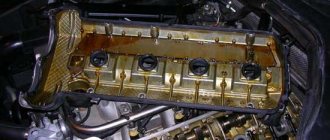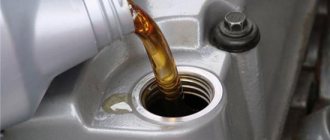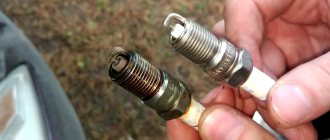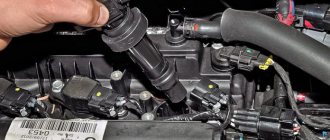Reasons for oily spark plugs
The main reasons for oil getting on spark plugs:
- Wear of valves and their parts: guides, seals, bushings, valve stem seals
- Piston ring wear
- Increased oil level in the engine crankcase
- Crankcase ventilation duct clogged
Valve wear
When the inner surface of the guides wears out, a large gap appears between the valve stem and the bushing, which allows oil from the cylinder head to enter the combustion chamber and onto the spark plugs.
Sometimes the guide bushing comes out of the head body. This usually occurs as a result of repeated replacement and installation of standard bushings instead of repair bushings (with an increased outer diameter).
Valve seals may leak oil into the combustion chamber due to hardening (“tanning”) of the rubber, stretching, or jumping off of the compression spring.
Oiling of the beginning of the spark plug thread near the ring is a sign of wear on the valve stem seals. It manifests itself as smoky exhaust when starting the engine.
When the valve stems themselves wear out, a large gap appears between them and the guide, which also leads to oil leakage into the combustion chamber.
Piston ring wear
When the piston rings wear out or cracks appear on the partitions under the rings, oil is sucked into the combustion chamber - the so-called pumping effect. In this case, it will be necessary to replace the rings, and possibly the pistons themselves when they are worn out.
If oil is detected at the end of the thread of the spark plugs and on the insulators themselves, it is necessary to check the compression in the engine cylinders with the spark plugs turned out.
Oil level too high
If the increased oil level is the result of a banal overflow, then the problem can be solved simply - the excess motor fluid is pumped out.
If the oil level rises due to coolant intrusion, the engine will most likely need to be repaired.
Crankcase ventilation system clogged
The crankcase ventilation system neutralizes the accumulation of crankcase gases and normalizes the pressure in the crankcase. If this system does not work properly, the pressure increases, causing oil to enter the combustion chamber.
As a result, the piston rings do not have time to “remove” excess oil from the cylinder walls, it enters the combustion chamber, the spark plugs become oily, etc.
The appearance of oil on the spark plugs is a fairly common problem that occurs due to engine fluid entering the combustion chamber. Oiling of the spark plugs is indicated by the engine shaking immediately after starting, a bluish tint of the exhaust gases, increased fuel consumption and oily deposits on the parts.
Let's figure out where the oil on the candle thread comes from and how to deal with this problem.
Reasons for oily spark plugs
The main reasons for oil getting on spark plugs:
- Wear of valves and their parts: guides, seals, bushings, valve stem seals
- Piston ring wear
- Increased oil level in the engine crankcase
- Crankcase ventilation duct clogged
Valve wear
When the inner surface of the guides wears out, a large gap appears between the valve stem and the bushing, which allows oil from the cylinder head to enter the combustion chamber and onto the spark plugs.
Sometimes the guide bushing comes out of the head body. This usually occurs as a result of repeated replacement and installation of standard bushings instead of repair bushings (with an increased outer diameter).
Valve seals may leak oil into the combustion chamber due to hardening (“tanning”) of the rubber, stretching, or jumping off of the compression spring.
Oiling of the beginning of the spark plug thread near the ring is a sign of wear on the valve stem seals. It manifests itself as smoky exhaust when starting the engine.
When the valve stems themselves wear out, a large gap appears between them and the guide, which also leads to oil leakage into the combustion chamber.
Piston ring wear
When the piston rings wear out or cracks appear on the partitions under the rings, oil is sucked into the combustion chamber - the so-called pumping effect. In this case, it will be necessary to replace the rings, and possibly the pistons themselves when they are worn out.
If oil is detected at the end of the thread of the spark plugs and on the insulators themselves, it is necessary to check the compression in the engine cylinders with the spark plugs turned out.
Oil level too high
If the increased oil level is the result of a banal overflow, then the problem can be solved simply - the excess motor fluid is pumped out.
If the oil level rises due to coolant intrusion, the engine will most likely need to be repaired.
Crankcase ventilation system clogged
The crankcase ventilation system neutralizes the accumulation of crankcase gases and normalizes the pressure in the crankcase. If this system does not work properly, the pressure increases, causing oil to enter the combustion chamber.
As a result, the piston rings do not have time to “remove” excess oil from the cylinder walls, it enters the combustion chamber, the spark plugs become oily, etc.
What is the danger of oil getting on the spark plug threads?
Oil getting into the combustion chamber and spark plug wells leads to the following problems:
- Engine tripping for some time after starting
- Increased exhaust toxicity
- Increased oil and fuel consumption (due to incorrect temperature conditions in the cylinders)
- Spontaneous and untimely combustion of the fuel mixture
- Loss of engine power
- Unstable vehicle dynamics
When oil gets into the combustion chamber and, as a result, onto the spark plugs, misfires are observed in individual cylinders. If the spark plugs are heavily oiled, one of the cylinders may stop working altogether.
When the spark plugs are oiled, starting the engine, especially in winter, causes difficulties. Removing and cleaning the spark plugs in this case does not help for long.
Solutions to the problem
Depending on what caused the oily spark plugs, there are several options for solving this problem: cleaning the crankcase ventilation system or decoking the engine.
Cleaning the crankcase ventilation system
The procedure is carried out as follows. After loosening the clamp, one end of the crankcase ventilation system pipe is disconnected from the air supply line, and the other from the fitting located on the cylinder head cover. After this, the hose is removed. The small branch pipe is dismantled in the same way - to do this, it is disconnected from the cylinder head and the fitting of the injection module. The supply pipe of the ventilation system is also removed after disconnecting from the BC and cylinder head fittings.
All pipes are washed with kerosene or fuel, then purged with air and dried. It would be a good idea to clean the fitting holes.
Next, the cylinder head cover is dismantled. Unscrew the screws securing the oil separator device on the inside of the cylinder head cover, remove the washers and the oil separator housing.
All grids are removed from the cylinder head. They must be washed with kerosene along with the cylinder head cover and the oil separating element.
All system components are assembled in reverse order.
Engine decarbonization
Decarbonization of the power unit is carried out as follows.
The high-voltage cables are dismantled and all spark plugs are removed. At this stage, it is advisable to remember their location. After this, the cables are unscrewed from the reels.
The engine oil is drained and a special decarbonizing agent is poured into the engine instead. The best option would be to decarbonize all cylinders of the internal combustion engine.
After this, the candles are effortlessly screwed into place to prevent evaporation of the product. The car is left for 6-12 hours (the operating time of the cleaner is specified in the instructions for it). Then the candles are carefully unscrewed again, all consumables are drained together with the remaining carbon deposits.
The engine is filled with fresh oil and “cranked” on the starter for about 10 seconds without installed spark plugs and a connected coil. Such actions will prevent water hammer when starting the internal combustion engine. At the end of the procedure, the candles are put in place.
What is the danger of oil getting on the spark plug threads?
Oil getting into the combustion chamber and spark plug wells leads to the following problems:
- Engine tripping for some time after starting
- Increased exhaust toxicity
- Increased oil and fuel consumption (due to incorrect temperature conditions in the cylinders)
- Spontaneous and untimely combustion of the fuel mixture
- Loss of engine power
- Unstable vehicle dynamics
When oil gets into the combustion chamber and, as a result, onto the spark plugs, misfires are observed in individual cylinders. If the spark plugs are heavily oiled, one of the cylinders may stop working altogether.
When the spark plugs are oiled, starting the engine, especially in winter, causes difficulties. Removing and cleaning the spark plugs in this case does not help for long.
What does the color of soot deposits indicate?
Using a color shade, you can quickly understand what problem areas are in the engine of your car. However, simply replacing samples will not solve the cause of soot - new spark plugs will very quickly become unusable. Currently, there are 3 main colors of deposits in the ignition system:
Each of the colors presented indicates the occurrence of a specific malfunction or group of problems in the car’s engine.
The appearance of black soot
This plaque can be either dry or oily. The appearance of a black coating in dry form indicates that an enriched mixture is being supplied to the engine. Candles become covered with such soot as a result of:
- Incorrect operation of carburetor systems;
- Clogged air filters;
- High pressure at the stage of fuel supply to the fuel rail;
- Little spark energy;
- Weak compression.
If black oily deposits appear, it is necessary to check the possibility of oil getting into the combustible fuel mixture itself. As a rule, oil leaks as a result of wear of the oil scraper type piston ring set. In addition, the cause of oil deposits can be damage to the valve system caps.
Advice: if you have recently repaired a VAZ-2114 generator, be sure to check the spark plugs. Perhaps some of the problems with the car lie there.
The appearance of white soot
White deposits in the ignition system can have several color shades:
- Slightly ashy colored deposits. Appear as a result of engine operation on low-quality gasoline samples. To solve the problem, you just need to remove and wipe the spark plug rings, after which they will become suitable for use again.
- Shiny white soot. Indicates the appearance of erosion on the body of the contact electrodes. It occurs as a result of overheating of the ignition system, and the cause may also lie in an insufficiently enriched fuel mixture. In addition, problems with early ignition and breakdowns in the cooling system can give such a tint. If the deposits are shiny white, it is best to replace the entire set.
Tip: if the spark appears weakly, a situation may occur when the car jerks when you press the gas pedal. This is also a common cause of a faulty spark plug set.
The appearance of brown or red soot
If red/brown deposits appear, you need to diagnose the fuel mixture entering the engine. Often this situation occurs when a large number of special additives are introduced into the car oil, which flush the engine cooling system. Also, the brown color on the spark plugs indicates that the engine has been running for a long time on a type of leaded gasoline.
As a result of the appearance of a brown conductive coating on the surface of the insulator, you will find disturbances in the normal formation of sparks. The car may not start for a long time and run intermittently at high speeds. To fix the problem, just clean the fuel system by adding new gasoline.
Tip: if there is no spark in the spark plugs, pay attention to the gaps in the electrodes. Perhaps they are covered with carbon deposits. To solve the problem, simply cleaning the spark plugs is not enough - you will need to replace the entire set, since if the situation repeats, problems will arise in the engine.
Solutions to the problem
Depending on what caused the oily spark plugs, there are several options for solving this problem: cleaning the crankcase ventilation system or decoking the engine.
Cleaning the crankcase ventilation system
The procedure is carried out as follows. After loosening the clamp, one end of the crankcase ventilation system pipe is disconnected from the air supply line, and the other from the fitting located on the cylinder head cover. After this, the hose is removed. The small branch pipe is dismantled in the same way - to do this, it is disconnected from the cylinder head and the fitting of the injection module. The supply pipe of the ventilation system is also removed after disconnecting from the BC and cylinder head fittings.
All pipes are washed with kerosene or fuel, then purged with air and dried. It would be a good idea to clean the fitting holes.
Next, the cylinder head cover is dismantled. Unscrew the screws securing the oil separator device on the inside of the cylinder head cover, remove the washers and the oil separator housing.
All grids are removed from the cylinder head. They must be washed with kerosene along with the cylinder head cover and the oil separating element.
All system components are assembled in reverse order.
Additional Information
Do not forget that the manufacturer strongly recommends changing spark plugs every 30 thousand km. To achieve the best effect, after completing the removal of oil from the spark plug well, it is advisable to blow it out. This allows you to eliminate various components that may affect further functionality (dirt, dust, remnants of tissue matter).
Thus, if you discover a malfunction of your Granta, in the form of flooded candles, do not despair! This problem can be solved with low costs and direct hands. The main thing is not to start the problem. If troubles caused by the lack of necessary tightness are resolved in a timely manner, it will not bring any consequences to the condition of the machine.
Is it possible to find out about a malfunction by flying?
If you need to find out the localization of a problem with the ignition cycle of the working fluid, it is the spark plugs that allow you to do this most accurately. It is worth remembering that it is impossible to characterize the position of the engine by spark plugs after a run of more than 20 thousand kilometers. Diagnostic methods are effective only on new parts, “fresh” and recently installed. A prerequisite is a running-in period of at least 250 kilometers. The algorithm for checking the engine condition using spark plugs looks like this:
- new spark plugs are being installed;
- running up to 200 (or more) kilometers;
- dismantle the elements and evaluate the shade of soot.
Important: The check must be performed exclusively on a warm engine.
Fills one spark plug with oil on 4 cylinders
- To the beginning of the forum
- Forum Rules
- Old design
- FAQ
- Search
- Users
the first three work well, they're all white
,
Before the capital, the car ate oil, but it burned, the spark plugs were black but dry
I bored out the block, changed the pistons and rings, and if you believe the mechanic, I also changed the valve guides and ground the valves. Maybe the cap actually broke? Solex hasn't done anything to the carburetor yet. The only question is, I bought a carburetor for a 1.2 engine, and if you believe the mechanic, it’s bored out, and at 1.5, do the jets in the carburetor need to be changed or something else?
A month ago I did a major overhaul of the engine, after which I drove 1000 km and lost 0.7 liters of oil. I unscrewed the spark plugs and saw that the first three worked well, they were all white, and the fourth was all covered in oil. I swapped the spark plugs, the same story, the spark plug was thrown again. At speed it works poorly, but it works, but in traffic jams it throws up so that it stops working, I unscrew the spark plug and the oil starts to drain. Before the capital, my car was eating oil, but it was burning, the spark plugs were black but dry, but the whole spark plug was wet, oil was flowing inside and along the threads. Nothing is leaking from under the valve cover. Does anyone have any ideas on this??
A month ago I did a major overhaul of the engine, after which I drove 1000 km and lost 0.7 liters of oil. I unscrewed the spark plugs and saw that the first three worked well, they were all white, and the fourth was all covered in oil. I swapped the spark plugs, the same story, the spark plug was thrown again. At speed it works poorly, but it works, but in traffic jams it throws up so that it stops working, I unscrew the spark plug and the oil starts to drain. Before the capital, my car was eating oil, but it was burning, the spark plugs were black but dry, but the whole spark plug was wet, oil was flowing inside and along the threads. Nothing is leaking from under the valve cover. Does anyone have any ideas on this??
Source
Candles flooded with oil - cause and solution. photo report
Candles flooded with oil - cause and solution. (photo report)
Post by Dron9l » Mar 22, 2012, 11:55 pm
77,000 km mileage, manual gearbox, red metallic, maximum specification - adaptive xenon is simply super. ))
Re: Spark plugs filled with oil, cause and solution.
Post by Dron9l » Mar 22, 2012, 11:59 pm
77,000 km mileage, manual gearbox, red metallic, maximum specification - adaptive xenon is simply super. ))
Re: Spark plugs filled with oil, cause and solution. (photo report
Message from Pilots » March 23, 2012, 00:57
Re: Spark plugs filled with oil, cause and solution. (photo report
Message from Pilots » March 23, 2012, 01:03
Re: Spark plugs filled with oil, cause and solution. (photo report
Message from Pilots » March 23, 2012, 01:03
Re: Spark plugs filled with oil, cause and solution. (photo report
Post by Dron9l » Mar 23, 2012 01:47
77,000 km mileage, manual gearbox, red metallic, maximum specification - adaptive xenon is simply super. ))
Re: Spark plugs filled with oil, cause and solution. (photo report
Post by fatez » Mar 23, 2012 09:35
Re: Spark plugs filled with oil, cause and solution. (photo report
Post by Dron9l » Mar 23, 2012, 11:13 am
77,000 km mileage, manual gearbox, red metallic, maximum specification - adaptive xenon is simply super. ))
Re: Spark plugs filled with oil, cause and solution. (photo report
Post by motorist » Mar 23, 2012, 02:23 pm
Re: Spark plugs filled with oil, cause and solution. (photo report
Post by SAILOR » March 23, 2012, 2:30 p.m.
Re: Spark plugs filled with oil, cause and solution. (photo report
Post by Dron9l » Mar 23, 2012 6:39 pm
77,000 km mileage, manual gearbox, red metallic, maximum specification - adaptive xenon is simply super. ))
Re: Spark plugs filled with oil, cause and solution. (photo report
Post by TAPEH » Mar 23, 2012, 11:44 pm
Re: Spark plugs filled with oil, cause and solution. (photo report
Post by Dron9l » Mar 23, 2012, 11:54 pm
Thank you! I'll be doing a cylinder compression test soon! There will also be a photo report with all the details.
77,000 km mileage, manual gearbox, red metallic, maximum specification - adaptive xenon is simply super. ))
Re: Spark plugs filled with oil, cause and solution. (photo report
Post by TAPEH » Mar 24, 2012 12:23 pm
Re: Spark plugs filled with oil, cause and solution. (photo report
Post by Dron9l » Mar 24, 2012 3:25 pm
Before replacing the valve cover gasket (oil was leaking into the spark plug wells), I also measured 16 kg per cylinder! But I suspect that this is too big, and this happened due to the presence of oil in the cylinders (perhaps it got into the cylinders through the wells)! Now the gasket (replaced) will break in and I will again check the presence of oil and measure the compression. I’ll post there to see if the compression has changed! and I’ll make a photo report as promised!
You didn't have any oil in the cylinders when you checked the compression. Did they turn off your fuel pump too?? since the pressure there is normal - and compression can lie.
77,000 km mileage, manual gearbox, red metallic, maximum specification - adaptive xenon is simply super. ))
Re: Spark plugs filled with oil, cause and solution. (photo report
Post by Dron9l » Mar 24, 2012 03:31 pm
Yes, but your oil consumption per 1000 km - a liter - is too much. Based on this consumption, I can assume that your piston rings may be worn out - hence the high pressure in the cylinders (“oil compression”)!! When your car runs on a cold start, is the exhaust not bluish (bluish) in color? and when you give the gas on a cold start, there is no pronounced blue haze. It’s possible that the valves can also be fooling!
77,000 km mileage, manual gearbox, red metallic, maximum specification - adaptive xenon is simply super. ))
Re: Spark plugs filled with oil, cause and solution. (photo report
Post by Dis5 » Mar 24, 2012, 11:44 pm
Re: Spark plugs filled with oil, cause and solution. (photo report
Post by Dron9l » Mar 25, 2012 08:55
77,000 km mileage, manual gearbox, red metallic, maximum specification - adaptive xenon is simply super. ))
Re: Spark plugs filled with oil, cause and solution. (photo report
Post by Lars » Mar 25, 2012, 03:11 pm
Re: Spark plugs filled with oil, cause and solution. (photo report
Post by Dron9l » Mar 25, 2012 04:14 pm
77,000 km mileage, manual gearbox, red metallic, maximum specification - adaptive xenon is simply super. ))
What's the result?
As you can see, oil in the engine cylinders can appear for various reasons. In all cases, an increase in lubricant consumption is observed, bluish smoke appears from the exhaust pipe, and the presence of lubricant on the spark plugs is also noted.
Let us add that usually spark plugs filled with oil cause difficult starting of the internal combustion engine, misfires and engine misfiring. In this situation, oil has to be constantly added, spark plugs need to be cleaned or replaced frequently, and such actions still do not solve the main problem.
It is important to understand that there should not be excess oil in the combustion chamber. Otherwise, the engine will be subject to increased wear, the combustion chamber will become dirty, valve seats and discs will suffer, as well as CPG elements. For this reason, it is necessary to promptly identify and eliminate the cause of the appearance of oil in the engine cylinder.
Consequences of a malfunction
If you ignore the problem of lubricant getting into the cylinders, which is indicated by traces of oil on the spark plug, the consequences will be very serious. The lubricant is not able to completely burn out in the cylinders, moreover, the part of it that does burn out becomes the cause of a large amount of soot.
This carbon deposits on the internal surfaces of the cylinder, which affects the processes taking place inside it, and also leads to the occurrence of rings. Because of this, the amount of oil entering the combustion chamber increases sharply. As a result, the engine power drops significantly, and it begins to intensively consume lubricant and fuel. Restoring the engine after this is quite difficult and financially expensive, since a major overhaul is required.
Video: Oil in spark plug wells, ICE 3S FE, eliminating the cause!
Oil in spark plug wells of Ford Focus 2. Getting rid of the annoying problem
Why do plastic windows sweat from the inside in an apartment and how to fix it
If, when replacing spark plugs, you find oil in the spark plug wells of a Ford Focus 2 (1.8 l), do not rush to immediately sound the alarm and go for help to the first service station you come across. Of course, the cause of leakage can be various factors, but, as a rule, the problem is completely solvable, although this depends on the type of engine and its model. Answering the question yourself is quite possible.
Plus, if you know how to use tools, doing the repair work yourself will be much safer. At least you will be sure that everything was done according to the instructions and with due passion.
Oil in spark plug wells Ford Focus 2
(as in many other brands of cars) appears as a result of wear of the gaskets. The main reason is quite simple. But what does it threaten if it is not eliminated in time?
Of course, this problem is not something particularly dangerous: complete leakage of oil from the engine or failure of the oil pump. In the end, you can drive with it (but it’s not recommended for too long), adding oil and wiping or changing spark plugs. But you will no longer be able to get true pleasure from driving.
The motor begins to behave inappropriately:
It’s wasting, consuming the wrong amount of oil (it seems like it was topped up yesterday, but the dipstick again shows a critical level of lubrication). And candles shorten their service life several times.
Who might like this? And it’s expensive to constantly spend money on topping up oil and replacing spark plugs. Isn't it easier to do repair work and fix any problems found?
- Moreover, it is quite possible to carry out repairs with your own hands in the home garage;
- We will prepare the necessary spare parts and tools. We need to take a valve cover gasket, seals, seals, lubricant, engine cleaner, a set of keys;
- We follow safety rules and carry out work (preferably in a closed and heated room in winter) in a box or garage. We do everything slowly and carefully, we believe in ourselves: then it should work out for sure;
- Remove the cover from the engine. Unscrew the screws from the electrodes and disconnect the terminals from the ignition coils;
- We take out the electrodes along with the coils (4 pieces);
- We unscrew the spark plugs using a socket wrench. We inspect them visually. As a rule, the picture that appears before us is rather ugly: the carving is covered in oil, the contacts are covered in soot and salt. By the way, this is another clear illustration of the fact that repairs need to be done, and as quickly as possible. And in the cylinder wells themselves, lubricant leaks are clearly visible (if you use a syringe, you can get up to 20 milliliters, but as a rule, less). There are leaks not in all of the wells tested. For example, they are common in the first two, but dry in the 3rd and 4th. Of course, you can try to tighten the lid on the oily side. But it’s better to solve the problem radically;
Therefore, we take a gasket (there are good ones - they are called Victor Reintz, the Germans seem to make them, but you can take a different brand) and try to change it. For this procedure, we unscrew the bolts to secure the valve covers (not forgetting about the protective ones under the engine cover), and remove the carbon electrodes along with the coils (ignition). Remove the valve cover; There is a groove on the cover itself for the gasket. You must remember to clean it to remove old dirt from sticking to it. During installation, the gasket is evenly applied and crimped. Otherwise, uncleaned areas will set a precedent for grease to start oozing out again, filling the wells. The gasket should be compressed evenly, crosswise, tightening on each side, making movements clearly and accurately. Don't overtighten! We first remove any leaked oil from the spark plug wells. We wipe everything thoroughly. It is best to screw in fresh, unused candles. Well, as a last resort, calcinate and clean the old ones (and also, it is advisable to check them at the appropriate stand).
After all the procedures performed, we assemble the entire structure in the reverse order of disassembly.











